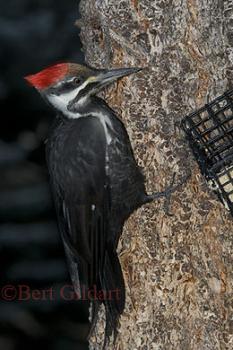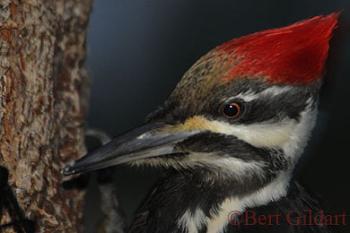Pileated Woodpeckers—Is it Hector or Hortense?

Hortense finds suet
©Bert Gildart: The Pileated Woodpecker is the largest of all woodpeckers, and every time one shows up at our feeder, I’ll alert Janie or she’ll alert me. “Hey,” called out Janie yesterday, “Hortense is back.” Several days ago, I alerted my wife. “It’s Hector!” I yelled. “He’s here again.”
MALE OR FEMALE?
Yes, we’ve actually taken to naming the birds. Hector is male and Hortense is female, and it’s easy to differentiate between the two, as Hector has a red mustache. On the other hand, the line above the upper mandible on Hortense is plain, meaning that she’s not so beautifully endowed. Or so I contend.
As you can see, yesterday Hortense, and not Hector, was at our feeder.
Neither of the two birds is casual about its arrival. Both arrive with a great deal of fanfare. Both know they want to feed on the suet that we’ve placed in a small grated container on the side of the huge Douglass Fir immediately adjacent to our much larger bird feeder, which we nailed to the railing.
CAUTIOUS APPROACH
The problem for them, however, is that they’re shy, and so they approach surreptitiously. Typically, following a loud Kik, kik; ki-ki-ki-ki-ki-ki-ki from some way-overhead perch, possibly from the huge cottonwood some 50 or so feet away, one will fly to the Doug fir, landing some 15 or 20 feet above the feeder. Then Hector or Hortense will make tiny leaps downward, each time a little closer. If they’re not particularly hungry, they’ll move down diagonally, peeping first from one side of the tree then the other. Finally, as they approach the suet, each seems to loose its reserve and then it will quickly scoot to the container of food.

Hortense–not Hector
Other woodpeckers also love the food source, and our feeder typically attracts Downies, Hairies, Red-Shafted flickers; all arouse our interest, but none so much as do these two Pileated. Neither seems to be particularly pugnacious, certainly not like the hummingbirds of the summer, which tolerate no competition what-so-ever. Pileated woodpeckers, however, seem relaxed with their large size, for neither seems overly aggressive–despite their potential power.
ADAPTED FOR FLIGHT
Both Hector and Hortense stand about 20 inches tall from stem to stern, weigh about 12 ounces, and have wing spans of almost two and a half feet. Like all other birds, they have hollow bones, air sacs, common urogenital openings; incredibly large and strong hearts coupled with powerful respiratory systems–feathers–all features designed to keep weight down and make flight possible. And these two Pileated can certainly do that.
When one has had its fill of suet, with a quick flap of its wings, Hector or Hortense is off. But we know they’re still around by their incessant chatter: ki-ki-ki-ki-ki-ki-ki.
On a cold winter day, we’re always glad for their company, and delighted we might be able to make their lives a little bit easier. Certainly, they (and all the other birds that alight on our feeders) enrich ours, as our other postings suggest. As you’ll see, the Pileated is a common visitor.
Camera used: Nikon D300


December 9th, 2007 at 11:55 am
Oh Bert.. what beautiful shots of Hector and Hortense..great names too! I love waking up to the sound of Pileated Woodpeckers when we camp. Seems like no matter where we go, there’s always a Pileated to wake up us up every morning. lol
Thank you for a wonderful look into your backyard my friend.
February 14th, 2008 at 1:44 pm
Bert-
We have Pileated Woodpeckers coming to our feeder in LaGrange Kentucky. The pileated, redbelly, harrys, downies, and nuthatches are so frequent, we make our own suet. The recipe is very simple and my husband makes 5 cakes at one time. It is a whole lot cheaper than buying it and it holds up great in the hot, humid weather in the summer. Let me know if you want the recipe.
June 24th, 2008 at 7:19 am
we feed all kinds of birds just recieved anesting pair of pileated woodpeckers wood love to have the recipe.
April 26th, 2009 at 1:58 pm
I would like to have the suet recipe as I buy a lot and like the fact that yours holds up better in hot weather.
May 21st, 2009 at 12:44 pm
Please send me your suet recipe.
May 24th, 2009 at 8:08 am
Hi Cherie,
I get lots of requests about the offer you made on my blog about pileated woodpeckers over a year ago–and your recipe for attracting them.
If the offer of suet recipe still exists, please forward. And let me know what kind of credit you want for the recipe.
Many thanks,
Bert
May 25th, 2009 at 6:03 pm
For those who have asked, here’s a recipe Cherie says she copied from Wildbird magazine. Cherie says she has been using the recipe for years. Hope it helps, and we may start using it too.
According to the article, the original recipe came from Martha Sargent, as follows:
NO-MELT, ALL SEASON PEANUT BUTTER SUET RECIPE
This recipe is easily doubled. We usually get about 4 cakes out of a doubled recipe.
1 cup crunchy peanut butter
2 cups “quick cook” oats
2 cups corn meal
1 cup of lard (NO SUBSTITUTIONS)
1 cup white flour
1/3 cup sugar
Melt the lard and peanut butter on medium heat, then stir in the remaining ingredients. Pour the mixture into square freezer containers (a size about the size of your suet cage) about 1 1/2 inches thick. Allow the suet to cool, put lids on the containers and put in them in the freezer. When you are ready to use, just pop them out of the containers.
In the winter, we have also added raisins, cranberries and other nuts as supplements. It takes very little time to mix up and put in containers and it saves a lot of money.
May 31st, 2009 at 8:32 am
Hi Bert-
It’s Cherie again. We are having a real problem with black birds eating the suet. I understand if you use an upside down suet feeder, the blackbirds will not go to it. My big question is if it will also deter the pileated woodpecker. That I don’t want to do. Any advice is appreciated!
June 1st, 2009 at 8:47 am
Hi Cherie,
Sorry, but don’t think I can provide much of an authoritative answer. My gut reaction, however, is that I don’t think feeder orientation would deter a pileated. Winds sometimes reposition feeders and HUNGRY birds still flock, making me wonder why an upside feeder would deter black birds. If you hear something more definitive, please let me–and my readers–know. Thanks!
June 21st, 2009 at 2:57 pm
I have tried an upside down feeder. My pileated woodpeckers seemed a little confused by it and wouldn’t stay on long. And the starlings, within a few days were hanging upside down on it. Needless to say, it’s in the garage and the double tailprop feeder is back up for them. I also tried the cage within a cage suet feeder, the starlings also ate that one and the pileateds wouldn’t even try it.
August 26th, 2009 at 6:13 pm
I have had a pair of pileated woodpeckers coming to my suet feeder for a month now. I also make my own suet and have all kinds of birds coming.. nuthatches, chickadees, downy, hairy, redbellied.. They all love the suet.. I have had luck with only one suet type of suet feeder.. I found it at Wild Birds Unlimited.. web address included in this emai..www.wbu.com. It is called the suet sandwich feeder. I take my suet and spread it in between two durable plactic pieces that resemble tree bark. The theory is that you keep the suet mostly to the inside so only the longue tongues of woodpeckers can retrieve it.. At first when I fill it, it comes out to the edges.. so sometimes I will get the occasional starling pecking at it.. but they cannot hold on for long and once it gets too far in the middle they cannot access it at all.. it’s brilliant.. They sell it there for around 32.00.. pricey yes, but it has more than paid for itself and I now have two because the bird activity is high at my feeders.. However, I was on their website and there is no listing for it at all.. they sell their bark butter which is what I was told to use in it but no mention of this feeder. Unless it is only sold in certain stores.. I would recommend if you have this store in your area, find out if they sell this item.. It has made my bird watching experience all that much more delightful..
If you would like to see a picture of it.. I would be glad to email anyone so you know what it looks like..
October 18th, 2009 at 6:57 pm
I was curious Michele what suet recipe you use to put in your sandwich feeder? I have a sandwich feeder.